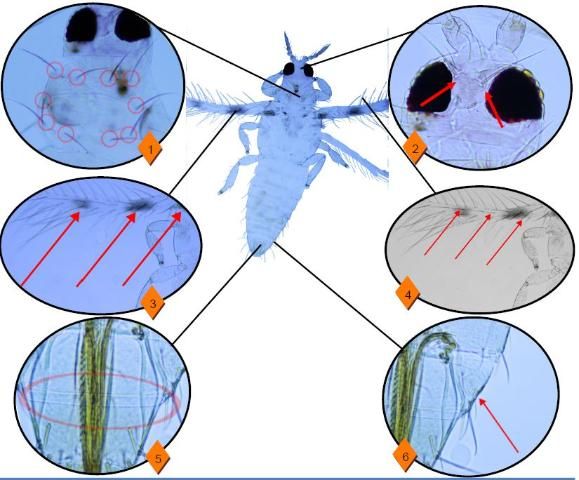Morphology

Credit: Jeffrey D. Cluever, UF/IFAS
- Extremely long setae on pronotum.
- Ocellar III setae extremely long and not arising between posterior ocelli.
- Three dark dots present on each forewing.
- Extremely long setae present on forewing.
- Comb on tergite VIII absent.
- Ctenidium on tergite VIII absent (arrow indicates spiracle).
Appearance
Egg
The eggs are minute and found inside plant foliage. These are unlikely to be seen.
Larvae
Light in color. Usually not identified.
Pupal Stages
The prepupa is recognized by the presence of wing buds and antennae that are straight. The pupa also has wing buds but the antennae are pulled back over the head. These stages are not usually identified.
Adult
Light in color. Its most distinctive feature is the six dark dots present on the forewings. Other distinctive features are the extremely long setae on the pronotum and forewings.
Other Diagnostic Features
Include ocellar III setae (major setae arising near the ocelli) that do not arise.
Life Cycle
Scolothrips sexmaculatus exhibits all the life stages common to terebrantian thrips: the egg, larva I, larva II, prepupa, pupa, and the adult. The length of each life stage and the number of progeny produced varies according to temperature and prey species.
At 25°C (77°F) when reared on a bean leaf substrate and a diet of Tetranychus urticae (twospotted spider mite), it takes 13.3 days to complete development from egg to adult. The individual stages are as follows:
- The female lays an egg into the foliage; 5.8 days later it hatches.
- The larva I and larva II stages feed on their prey for 2.5 and 2.3 days respectively.
- The non-feeding prepupa and pupa last 2.7 days collectively before the emergence of the adult.
At this temperature a female can lay about 200 eggs in her lifetime.
Prey and Distribution
Scolothrips sexmaculatus feeds on pest mites including spider mites (Acari: Tetranychidae), European red mite (Panonychus ulmi), and the cyclamen mite (Phytonemus pallidus). Cannibalism may occur if prey are scarce.
Prey Consumption Rate
Larva
10 mite eggs/day
Adult
60 mite eggs/day.
Origin
North America
Geographic Distribution
North America. S. pallidus and S. sexmaculatus are present in Florida and may be the same species.
Further Reading
Diffie, S., G. B. Edwards, and L. A. Mound. 2008. "Thysanoptera of the southeastern U.S.A.: A checklist for Florida and Georgia." Zootaxa 1787: 45–62.
Hoddle, M.S., L.A. Mound, and D. Paris. 2012. Thrips of California. CBIT Publishing, Queensland. http://keys.lucidcentral.org/keys/v3/thrips_of_california/Thrips_of_California.html
Pakyari, H., Y. Fathipour, and A. Enkegaard. 2011. "Effect of temperature on life table parameters of the thrips Scolothrips longicornis (Thysanoptera: Thripidae) fed on twospotted spider mites (Acari: Tetranychidae)." Economic Entomology 104: 799–805.